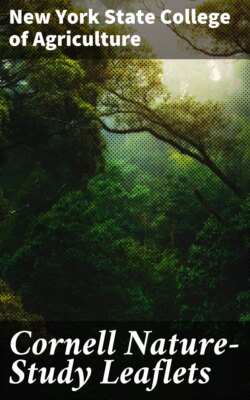Читать книгу Cornell Nature-Study Leaflets - New York State College of Agriculture - Страница 42
На сайте Литреса книга снята с продажи.
LEAFLET VII.
A SNOW STORM.[9] By ANNA BOTSFORD COMSTOCK.
ОглавлениеTable of Contents
The snow had begun in the gloaming, And busily all the night Had been heaping field and highway With a silence deep and white. Every pine and fir and hemlock Wore ermine too dear for an earl, And the poorest twig on the elm-tree Was ridged inch deep with pearl. From sheds new-roofed with Carrara Came Chanticleer's muffled crow The stiff rails were softened to swan's-down And still fluttered down the snow. —Lowell.
The storm which Lowell describes so delightfully is the first soft, gentle snow fall that comes in November or early December. "The silence deep and white" settles like a benediction over the brown, uneven landscape, and makes of it a scene of enchantment. Very different from this is the storm that comes when the winter cold is most severe and winter winds most terrific. Then the skies are as white as the fields, with never a sign of blue; if the sun appears at all, it shines cold instead of warm, and seems but a vague white spot behind the veil of upward, downward whirling snowflakes; the wild wind takes the "snow dust" in eddies across the fields and piles it at the fences in great drift billows with overhanging crests. On such a day the snow is so cold and dry, the clouds so low and oppressive, the bare trees so brown and bleak, that we shiver even though we gaze on the dreary scene from the window of a warm and comfortable room.
Fig. 19. Snow crystals enlarged.
But another change is sure to come. Some February day the wind will veer suddenly to the south and breathe warm thawing breaths over the white frozen world. Then will the forests appear in robes of vivid blue-purple against the shining hills; and in the mornings the soft blue of the horizon will shade upward into rose-color and still upward into yellow and beryl green; these hues are never seen on the forest or in the sky except when the snow covers the earth to the horizon line. The eye that loves color could ill afford to lose from the world the purples and blues which bring contrast into the winter landscape.
The snow storm to our limited understanding, begins with a miracle—the miracle of crystallization. Why should water freezing freely in the air be a part of geometry, the six rays of the snow crystal growing at an angle one to another, of sixty degrees? Or as if to prove geometry divine beyond cavil, sometimes the rays include angles of twice sixty degrees. Then why should the decorations of the rays assume thousands of intricate, beautiful forms, each ray of a flake ornamented exactly like its five sisters? And why should the snowflake formed in the higher clouds of the upper air be tabular in shape but still, in cross section, show that it is built on the plan of six radii? Look at it as we will, the formation of a crystal is a beautiful mystery and is as unfathomable as is the mystery of life.
Fig. 20. Snow crystals enlarged.
I am indebted to the courtesy of Mr. R. G. Allen, Section Director for New York of the U. S. Weather Bureau, for suggestions in making out the following questions. The beautiful pictures of snow crystals illustrating this lesson were made from photographs taken by Mr. W. A. Bentley of Jericho, Vt. It is our desire to interest all teachers in the natural history of a snow storm, to the end that "they may love the country better and be content to live therein."
A thermometer hung in a sheltered, open place away from the warmth of the house is a necessary preliminary to the proper observation of the phenomena of a snow storm.
Dark woolen cloth is the best medium on which to catch and observe snow crystals.
Fig. 21. "With a silence deep and white."
